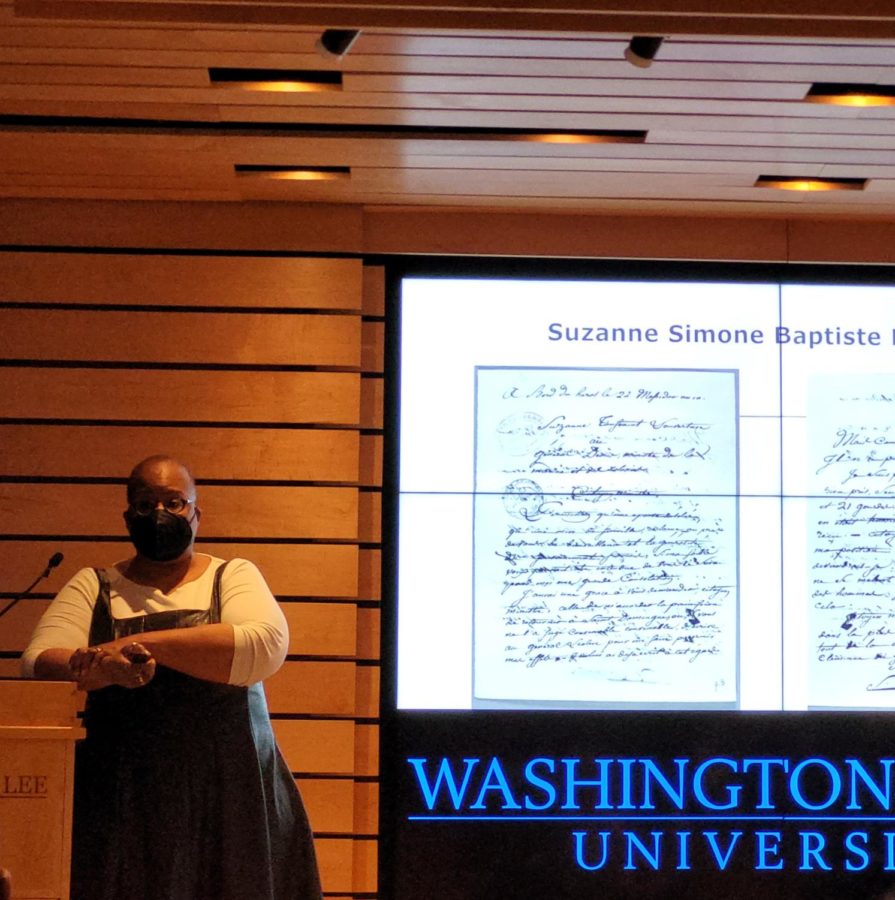Dr. Robin Mitchell uncovers hidden history of Suzanne Simone Baptiste
Students gained unique insight into the research process behind the first biography of Toussaint Louverture’s wife
Despite the lack of letters written by Baptiste herself, Mitchell is working to piece together a timeline of her life. Photo by Emma Malinak, ‘25.
March 15, 2022
How do you write a biography about a woman who has been erased from history?
For award-winning historian Robin Mitchell, the key to uncovering Suzanne Simone Baptiste’s hidden story is asking creative questions.
“Tonight, you are going to hear more questions than answers,” Mitchell said as she began her presentation at Washington and Lee on March 2. “I’m trying to look into the shadows to find what’s been erased.”
Mitchell specializes in 19th-century French history, with a focus in race and gender studies. She currently works at Harvard University’s Radcliffe Institute for Advanced Study, conducting research for the first biography of Baptiste.
At her public lecture in Northen Auditorium, Mitchell presented the information she has gathered so far and the questions that remain unanswered. Utilizing her background in microhistory research, Mitchell is piecing together the timeline of Baptiste’s life.
Baptiste was born into slavery in the French colony of St. Domingue, in modern-day Haiti, in the mid-18th century (her exact date of birth is unknown). Baptiste married Toussaint Louverture, a leader of the Hatian Revolution that began in 1791.
As Louverture became more renowned for his military leadership, Baptiste became Louverture’s proxy, running his plantations and taking care of familial duties.
After the revolution subsided at the turn of the century, Louverture stood as a threat to the French government due to his ability to plot another uprising. Thus, Louverture and Baptiste were captured and taken to France, where Louverture died in 1803.
However, Baptiste’s life in France is virtually invisible in the historical record. Her story is “opaque,” as Mitchell describes it, and is surrounded by rumors and false accounts. Mitchell has found only three letters written by Baptiste herself, and she has struggled to find Baptiste’s voice within other sources.
Sarah Horowitz, history professor and head of the women’s, gender and sexuality studies (WGSS) program, explained the difficulty of relying on primary sources.
“It’s very difficult to reconstruct the lives of people who don’t have a lengthy paper trail,” Horowitz said.
On the flip side, Mitchell has found over 80 letters written by Louverture about his wife. They claim Baptiste was a feeble-minded, helpless old woman who could do nothing more than hide in the background. In the letters, Louverture did everything he could to express how little Baptiste mattered.
Mitchell said she thinks that this evidence means that Baptiste did matter.
“It highlights how dangerous she was, or at least how dangerous the government thought she was,” said Mitchell.
More research has revealed that Louverture’s lies about Baptiste were precautions he took to ensure his wife would remain safe. He painted Baptiste as a woman who was incapable of knowing political secrets or staging a revolution so she would not be considered a threat to the French government. His strategy worked, and Baptiste was able to safely live in France until her death in 1816.
While the lies that depicted Baptiste as an unassuming, innocent character saved her life, they also forced her to disappear from the historical record.
Taylor Walle, English professor, spoke on the issue of this subjectivity of history.
“Even though archives are framed as objective records, they are in fact shaped by people in power,” Walle said.“Telling Baptiste’s story reorients our understanding of the past.”
Mitchell is trying to find out where Baptiste, a woman at the center of the Hatian Revolution and the tense gender and race relations of 19th-century France, fits into this reorientation.
“There is something really powerful about being able to say where you come from,” Mitchell said. She said she wants to give that power back to Baptiste.
As a Robert S. Griffith Jr. ’52 Visiting Scholar, Mitchell worked with the WGSS program and the history department at Washington and Lee for the first two weeks of March. In addition to presenting her public lecture, Mitchell taught in the WGSS capstone class, hosted a women’s history trivia night with Gender Action Group and College Democrats, and talked with faculty about objectivity and neutrality in teaching.
Students said they have benefited from Mitchell’s in-depth explanation of her research process.
“I like how she walked us through her research thus far and then moved into what she’s planning for the future,” said Stefanie Lehman, ’25.
After her stay on campus, Mitchell will continue to mine data in secondary sources, locate and translate primary source documents and construct a timeline of Baptiste’s life. She plans to publish the biography with Princeton University Press in 2024.
“Telling the story of people who have been hidden from history reveals a more complex, rich and exciting view of the past,” Horowitz said. “That can also help us understand who, in today’s society, isn’t having their story told.”














Oni • May 2, 2023 at 2:01 am
As a storyteller planning to share stories with teenage orphan girls in Haiti, I sought out info on Madam L’ouverture and i must tell you my beloved sister your work is greatly appreciated and more books must be written about the support & love every man of substance has in the wives and or woman in their lives. I look forward to reading your book.
Nyanza Signifis • Jan 4, 2023 at 12:09 pm
Thank you for your participation on finding untold history of this brave and loyal woman.
I do plays about them and always searching for more info.
Thank you and I appreciate you.